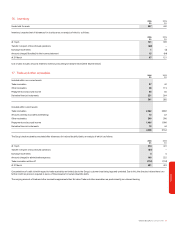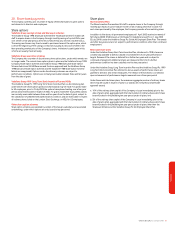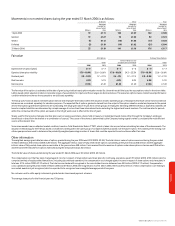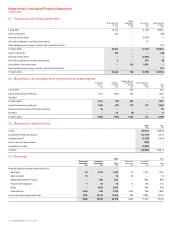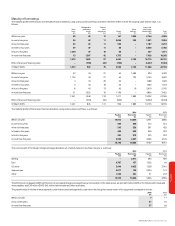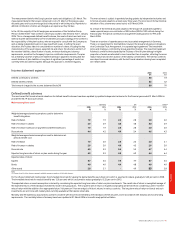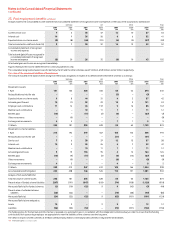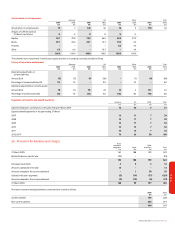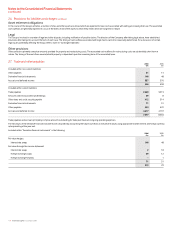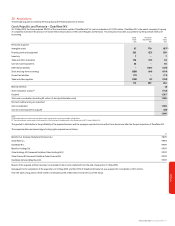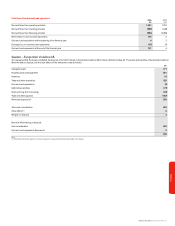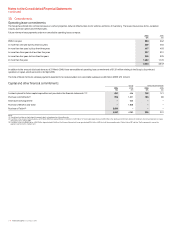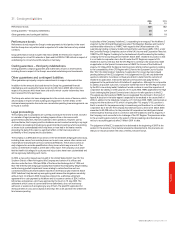Vodafone 2006 Annual Report Download - page 109
Download and view the complete annual report
Please find page 109 of the 2006 Vodafone annual report below. You can navigate through the pages in the report by either clicking on the pages listed below, or by using the keyword search tool below to find specific information within the annual report.
Vodafone Group Plc Annual Report 2006 107
Financials
The measurement date for the Group’s pension assets and obligations is 31 March. The
measurement date for the Group’s net periodic cost is 31 March of the previous year.
Actuarial gains and losses are recognised in the period in which they arise. Payments to
defined contribution schemes are charged as an expense as they fall due.
In the UK, the majority of the UK employees are members of the Vodafone Group
Pension Scheme (the “main scheme”), which was closed to new entrants from 1 January
2006. This is a tax approved defined benefit scheme, the assets of which are held in an
external trustee-administered fund. The investment policy and strategy of the scheme is
the responsibility of the plan trustees, who are required to consult with the Company as
well as taking independent advice on key investment issues. In setting the asset
allocation, the Trustees take into consideration a number of criteria, including the key
characteristics of the asset classes, expected risk and return, the structure and term of
the member liabilities, diversification of assets, minimum funding and solvency
requirements, as well as the Company’s input on contribution requirements. The plan
has a relatively low level of pensioner liabilities already in payment, meaning that the
overall duration of plan liabilities is long term. A significant percentage of assets has
currently been allocated to equities although this approach is reviewed regularly.
The main scheme is subject to quarterly funding updates by independent actuaries and
to formal actuarial valuations at least every three years. The most recent formal triennial
valuation of this scheme was carried out as at 31 March 2004.
As a result of the triennial actuarial valuation, the Group’s UK subsidiaries agreed to
make a special lump sum contribution of £30 million (2005: £100 million) during the
financial year. The special contributions brought the funding position to 99% at 31
March 2006.
There are a number of separate pension and associated arrangements in Germany.
There is no requirement to fund liabilities, however the Group funds pension obligations
via a Contractual Trust Arrangement, in a separate legal agreement. The investment
policy and strategy is controlled by Group appointed trustees. The investment approach
followed is similar to that adopted by the Trustees of the UK plan although a higher
proportion of assets are allocated to bond securities than to equities, reflecting the more
mature nature and shorter duration of the liability commitments. The German schemes
are subject to annual valuations, with the last formal valuations having been completed
at 31 March 2006.
Income statement expense 2006 2005
£m £m
Defined contributions schemes 28 18
Defined benefit schemes 52 52
Total amount charged to the income statement (note 34) 80 70
Defined benefit schemes
The most recent full formal actuarial valuations for defined benefit schemes have been updated by qualified independent actuaries for the financial year ended 31 March 2006 to
provide the IAS 19 disclosures below.
Major assumptions used Germany UK Other(1)
2006 2005 2006 2005 2006 2005
%%%%%%
Weighted average actuarial assumptions used to determine
benefit obligations:
Rate of inflation 1.9 1.9 2.8 2.8 2.0 2.0
Rate of increase in salaries 2.9 2.9 4.8 4.8 3.0 2.9
Rate of increase in pensions in payment and deferred pensions 1.9 1.9 2.8 2.8 2.0 2.0
Discount rate 4.4 4.5 4.9 5.4 4.6 4.3
Weighted average actuarial assumptions used to determine net
periodic benefit cost:
Rate of inflation 1.9 2.0 2.8 2.5 2.0 2.1
Rate of increase in salaries 2.9 3.0 4.8 4.5 2.9 3.0
Discount rate 4.5 5.3 5.4 5.5 4.7 4.4
Expected long term rate of return on plan assets during the year 4.9 5.3 6.8 6.9 6.4 6.4
Expected rates of return:
Equities 6.7 6.6 7.4 7.7 6.7 6.6
Bonds 4.0 4.0 4.4 4.8 4.0 4.0
Other assets 2.8 2.1 -4.9 5
5..332.8
Note:
(1) Figures shown for other schemes represent weighted average assumptions of individual schemes.
For the US post retirement medical plan, the immediate trend rate for valuing the dental benefits was 6.5 per cent, which is assumed to reduce gradually to 5.25 per cent in 2008.
The immediate trend rate for medical benefits was 12.0 per cent, which is assumed to reduce gradually to 5.25 per cent in 2013.
The expected return on assets assumption is derived by considering the expected long term rates of return on plan investments. The overall rate of return is a weighted average of
the expected returns of the individual investments made in the group plans. The long term rate of return on equities and property are derived from considering current “risk free”
rates of return with the addition of an appropriate future “risk premium” from an analysis of historic returns in various countries. The long term rates of return on bonds and cash
investments are set in line with market yields currently available at the balance sheet date.
Mortality and life expectancy assumptions used are consistent with those recommended by the individual scheme actuaries, and in accordance with statutory and local funding
requirements. The mortality tables in Germany have been updated at 31 March 2006 in line with newly published tables.


